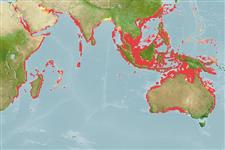Classification / Names
Common names from other countries
Main reference
Size / Weight / Age
Max length : 60.0 cm FL male/unsexed; (Ref. 1287)
Length at first maturity
Lm 30.0, range 19 - 35 cm
Environment
Marine; reef-associated; amphidromous (Ref. 51243); depth range ? - 700 m (Ref. 100719), usually 20 - 60 m (Ref. 54876)
Climate / Range
Tropical, preferred 27°C (Ref. 107945); 30°N - 35°S, 32°E - 155°E
Distribution
Indo-West Pacific: Red Sea and east coast of Africa (except Kenya), including Madagascar to the Persian Gulf, Arabian Sea (Ref. 9819), and further east to southeast Asia and Australia. Does not appear to occur in the central or eastern Pacific.
Countries | FAO areas | Ecosystems | Occurrences | Introductions
Short description
Dorsal
spines
(total): 0;
Dorsal
soft rays
(total): 11-13;
Anal
spines: 0;
Anal
soft rays: 10 - 11. Body is cigar-shaped, rounded or slightly compressed; the head pointed and depressed; the snout broader than long. Color is generally brown above and silver below; the back with faint cross bands. The tips of the dorsal and pectorals and the lower caudal lobe blackish.
IUCN Red List Status (Ref. 115185)
Threat to humans
Harmless
Human uses
Fisheries: commercial
More information
ReferencesAquacultureAquaculture profileStrainsGeneticsAllele frequenciesHeritabilityDiseasesProcessingMass conversion
Tools
Special reports
Download XML
Internet sources
Estimates of some properties based on models
Phylogenetic diversity index
PD50 = 0.5000 many relatives (e.g. carps) 0.5 - 2.0 few relatives (e.g. lungfishes)
Trophic Level
4.4 ±0.3 se; Based on diet studies.
Resilience
Medium, minimum population doubling time 1.4 - 4.4 years (K=0.08-0.29; tmax=7)
Vulnerability
Moderate vulnerability (36 of 100)
Price category
